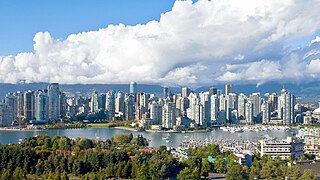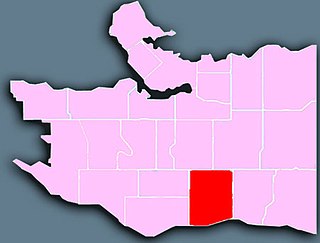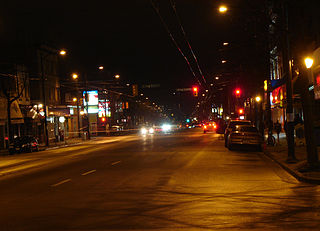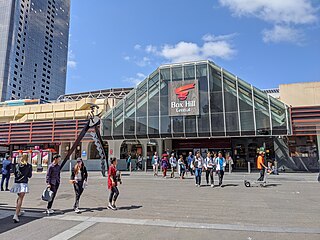
The Lower Mainland is a geographic and cultural region of the mainland coast of British Columbia that generally comprises the regional districts of Metro Vancouver and Fraser Valley. Home to approximately 3.05 million people as of the 2021 Canadian census, the Lower Mainland contains sixteen of the province's 30 most populous municipalities and approximately 60% of the province's total population.

Vancouver is a major city in western Canada, located in the Lower Mainland region of British Columbia. As the most populous city in the province, the 2021 Canadian census recorded 662,248 people in the city, up from 631,486 in 2016. The Greater Vancouver area had a population of 2.6 million in 2021, making it the third-largest metropolitan area in Canada. Greater Vancouver, along with the Fraser Valley, comprises the Lower Mainland with a regional population of over 3 million. Vancouver has the highest population density in Canada, with over 5,700 people per square kilometre, and fourth highest in North America.

New Westminster is a city in the Lower Mainland region of British Columbia, Canada, and a member municipality of the Metro Vancouver Regional District. It was founded by Major-General Richard Moody as the capital of the Colony of British Columbia in 1858 and continued in that role until the Mainland and Island colonies were merged in 1866. It was the British Columbia Mainland's largest city from that year until it was passed in population by Vancouver during the first decade of the 20th century.

In architecture and city planning, a terrace or terraced house (UK) or townhouse (US) is a form of medium-density housing that originated in Europe in the 16th century, whereby a row of attached dwellings share side walls. In the United States and Canada they are also known as row houses or row homes, found in older cities such as Philadelphia, Baltimore, and Toronto.

Chinatown is a neighbourhood in Vancouver, British Columbia, and is Canada's largest Chinatown. Centered around Pender Street, it is surrounded by Gastown to the north, the Downtown financial and central business districts to the west, the Georgia Viaduct and the False Creek inlet to the south, the Downtown Eastside and the remnant of old Japantown to the northeast, and the residential neighbourhood of Strathcona to the southeast.

Yaletown is an area of Downtown Vancouver, Canada, bordered by False Creek and Robson and Homer Streets. Formerly a heavy industrial area dominated by warehouses and rail yards, since the 1986 World's Fair it has been transformed into one of the most densely populated neighbourhoods in the city.
The Punjabi Market, also known as Little Punjab or Little India, is a commercial district and ethnic enclave in Vancouver, British Columbia. Officially recognized by the city as being primarily a major South Asian, Indo-Canadian and Punjabi population business community and cultural area, the Punjabi District is roughly a six block section of Main Street around 49th Avenue in the Sunset neighbourhood, named after its historically large Punjabi Sikh population.

The architecture of Canada is, with the exception of that of Canadian First Nations, closely linked to the techniques and styles developed in Canada, Europe and the United States. However, design has long needed to be adapted to Canada's climate and geography, and at times has also reflected the uniqueness of Canadian culture.

Strathcona is the oldest residential neighbourhood of Vancouver, British Columbia, Canada. Officially a part of the East Side, it is bordered by Downtown Vancouver's Chinatown neighbourhood and the False Creek inlet to the west, Downtown Eastside to the north, Grandview-Woodland to the east, and Mount Pleasant to the south of Emily Carr University and the Canadian National Railway and Great Northern Railway classification yards.

The history of Vancouver, British Columbia, is one that extends back thousands of years, with its first inhabitants arriving in the area following the Last Glacial Period. With its location on the western coast of Canada near the mouth of the Fraser River and on the waterways of the Strait of Georgia, Howe Sound, Burrard Inlet, and their tributaries, Vancouver has – for thousands of years – been a place of meeting, trade, and settlement.

East Vancouver is a region within the city of Vancouver, British Columbia, Canada. Geographically, East Vancouver is bordered to the north by Burrard Inlet, to the south by the Fraser River, and to the east by the city of Burnaby. East Vancouver is divided from Vancouver's "West Side" by Ontario Street.

Sunset is the most ethnically diverse neighbourhood in Vancouver, British Columbia. It is located in the south-east quadrant of the city. Surrounding the multicultural Fraser Street district, Sunset is bordered by both the Marpole and Oakridge neighbourhoods to the west, and the Victoria-Fraserview neighbourhood to the east.

Strawberry box houses or Strawberry-box bungalow was a style of homes built during World War II and into the 1950s to 1960s and found throughout Canada. The style uses a square or rectangular foundation and named due to the similarity with boxes used to hold strawberries. This style has also been called the "Simplified Cape Cod", or "Victory Houses" in the case of certain government advertisements.

Main Street is a major north–south thoroughfare bisecting Vancouver, British Columbia, Canada. It runs from Waterfront Road by Burrard Inlet in the north, to Kent Avenue alongside the north arm of the Fraser River in the south.

An ethnoburb is a suburban residential and business area with a notable cluster of a particular ethnic minority population. Although the group may not constitute the majority within the region, it is a significant amount of the population. That can greatly influence the social geography within the area because of cultural and religious traditional values exhibited. Ethnoburbs allow for ethnic minority groups to maintain their individual identity, but that may also restrict their ability to fully assimilate into mainstream culture and society.

Vancouverism is an urban planning and architectural phenomenon in Vancouver, British Columbia, Canada. It is characterized by a large residential population living in the city centre with mixed-use developments, typically with a medium-height, commercial base and narrow, high-rise residential towers, significant reliance on mass public transit, creation and maintenance of green park spaces, and preserving view corridors. The architect Bing Thom described Vancouverism this way:
It's a spirit about public space. I think Vancouverites are very, very proud that we built a city that really has a tremendous amount of space on the waterfront for people to recreate and to enjoy. At the same time, False Creek and Coal Harbour were previously industrial lands that were very polluted and desecrated. We've refreshed all of this with new development, and people have access to the water and the views. So, to me, it's this idea of having a lot people living very close together, mixing the uses. So, we have apartments on top of stores. In Surrey we have a university on top of a shopping centre. This mixing of uses reflects Vancouver in terms of our culture and how we live together.

Rockland is a historic neighbourhood of Victoria, British Columbia, Canada, located just southeast of downtown and northeast of Beacon Hill Park, and comprising the northern portion of the official city neighbourhood of Fairfield. Its boundaries are imprecise but the area roughly flanks Rockland Avenue.

The architecture of Vancouver and the Greater Vancouver area consists of a variety of modern architectural styles, such as the 20th century Edwardian style and the 21st century modernist style, as well as many others. Initially, the city's architects embraced styles and ideas developed in Europe and the United States, with only limited local variation.
Chinese Canadians are a sizable part of the population in Greater Vancouver, especially in the Chinese communities in the city of Vancouver and the adjoining suburban city of Richmond. The legacy of Chinese immigration is prevalent throughout the Vancouver area.
The Canadian property bubble refers to a significant rise in Canadian real estate prices from 2002 to present which some observers have called a real estate bubble. From 2003 to 2018, Canada saw an increase in home and property prices of up to 337% in some cities. By 2018, home-owning costs were above 1990 levels when Canada saw its last housing bubble burst. Bloomberg Economics ranks Canada as the second largest housing bubble across the OECD in 2019 and 2021. Starting in February 2022, prices started to decline rapidly as the Bank of Canada hiked interest rates culminating in detached prices to decline by $400,000 in the Greater Toronto Area by September of 2022.
















